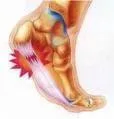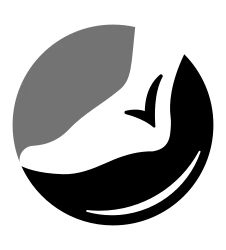Plantar Fasciitis
PLANTAR FASCIITIS (HEEL PAIN OR HEEL SPURS)
Plantar Fascitis is one of the most common reasons for heel pain. It is also sometimes referred to as heel spur syndrome when accompanied by a spur at the base of the heel. We at the OC Foot and Ankle Associates are strong advocates of aggressive conservative treatment for heel pain. However, heel pain that persists longer than 6 months, despite conservative treatment, should be evaluated closely and we are committed to providing you with all available options including Topaz Micro-Ablation, Extracorporeal Shockwave therapy, a noninvasive treatment for persistent heel pain and Endoscopic Plantar Fasciotomy when all other measures have failed. We are one of the few physicians in Southern California certified in performing revolutionary nonsurgical Neurotherm for chronic heel pain.

WHAT IS THE PLANTAR FASCIA:
Plantar fascia is a ligament on the bottom part of your foot that runs from the heel to the ball of the foot. Some of the fibers of the Achilles tendon in the back of your leg continue on to the form the plantar fascia on the bottom of the foot. Plantar fasciitis refers to an inflammation of this ligament at the point where it attaches into the heel. This condition is sometimes referred to as heel spur syndrome because occasionally on x-ray, you may see a bone spur at the area where this plantar fascia attaches. Numerous studies have shown that the bone spur itself does not cause the pain but is just an indication that the plantar fascia has probably been tight over numerous years and is constantly pulling on the bone. People can have absolutely no heel spur and have tremendous pain or vice-versa, have very large spurs on x-ray but no symptoms at all.
DIAGNOSIS :
The most important process in the treatment of plantar fascitis is the initial diagnosis. OC Foot and Ankle Associates strive to reach an accurate and timely diagnosis and render aggressive treatment of plantar fascitis with state of the art equipment. Many of the diagnosis and treatments for plantar fascitis have been time test and routinely utilized. . Diagnosis is made with x-rays of both feet (for comparison) to make sure there are no fractures, bone tumors, arthritic changes, and/or spurs in the heel and surrounding joints. Ultrasound is used to check the fascia for either a partial or complete tear. The fascia is then measured to assess the level of scar tissue and damage. Neurosensory testing, a non painful nerve test, may be used to make sure there is not a local nerve problem.
WHY?
Think of the plantar fascia like a rubber band that supports the arch of your foot. With time, age, increased activity, injury, long term use of poor shoe gear, weight gain, or pregnancy, changes to the ligaments of our feet occur. Repeated strain can cause tiny tears in the ligament.
This is more likely to happen if:
Your feet roll inward too much when you walk (excessive pronation).
You have high arches or flat feet.
You walk, stand, or run for long periods of time, especially on hard surfaces. You are overweight.
You wear shoes that don't fit well or are worn out.
You have tight Achilles tendons or calf muscles.
SYMPTOMS OF PLANTAR FASCIITIS:
Most common complaint with this condition is a deep, achiness feeling, especially with the first step in the morning or with the first step after a period of sitting. The reason for this is that while sleeping or sitting, the plantar fascia contracts and when you stand and put weight on it, you will feel a jolt of tension which is actually the ligament pulling on the heel. It usually begins to feel better after several steps but may return again after being on it for a prolonged amount of time.
CONSERVATIVE TREATMENT:
After complete evaluation of your foot including clinical and radiographic (x-ray) exam, conservative treatment may include stretching,icing, anti-inflammatories, physical therapy, cortisone injections, orthotics, night splints, immobilization, and possible restrictions on weight-bearing. We ensure each treatment program to be individualized based on your needs.
SURGICAL TREATMENTS
Surgery is reserved for chronic cases of plantar fascitis that do not improve with all types of conservative care. The surgical technique chosen by Dr. Kanda, Dr. Chang, and Dr. Mehtani will depend of the severity of the fascitis.
The surgeons at OC Foot and Ankle are one of the few doctors to perform a minimally invasive surgical technique is called Coblation Surgery (cool ablation)using a Topaz probe. Topaz coblation surgery is a procedure that involves controlled burning of multiple tiny holes through the skin and through the plantar fascia in the heel. The ablation holes irritate the fascia enough to turn a chronic problem into an acute problem and increases circulation to the damaged area. This sends signals to the brain that there is a new injury, and the body responds accordingly. The patient's own body then increases the natural healing properties which will begin to heal the newly injured ligament. This new acute injury to the ligament will be healed in a controlled environment with the foot immobilized in a boot for 2- 4 weeks. Return to walking immediately after surgery.
Shockwave Therapy utilizes a series of low-energy/high energy jolts to the heel which causes acute injury to the heel, thereby resulting in a cascade of re-microvascularization and triggering the body's own healing mechanism to respond to the trauma.
If all forms of care fail including Topaz minimally invasive surgery and Shockwave therapy, a fascia release surgery is used to release of the tight fascia. The physicians at OC Foot and Ankle utilize an endoscopic (camera guided) approach for fascia release to allow rapid healing and limited downtime. Patients are able to walk immediately after the surgery.
